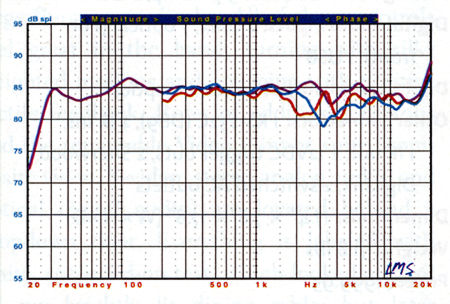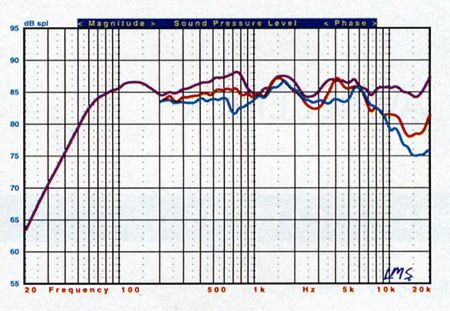Revel Performa surround speaker system Measurements
All measurements of the Revel Performa F32 and C32 were made with their grilles in place. With the grilles on, the responses of both speakers were less smooth, producing additional deviations of up to +/-2dB in the high frequencies.
The impedance of the Performa F32, mea-sured with the tweeter-level and boundary controls set to "0" and Normal, respectively, is typical of a ported enclosure tuned to approximately 30Hz, with a minimum impedance of 3.7ohms at 30Hz. I would rate the speaker's nominal impedance at 4.5ohms. With this impedance, and its sensitivity of approximately 85dB/2.83V/m, I would judge the F32 to be a moderately difficult load to drive, though it should be no problem for a competent amplifier.

Fig.1: Revel Performa F32, pseudo-anechoic response off horizontal axis at 45° (red) and 60° (blue).
The F32's horizontal front response is shown in Fig.1 (violet). This is the pseudo-anechoic response averaged over a +/-15° forward horizontal angle, at tweeter height and at 1 meter, combined with the nearfield responses of the woofers and port. The bass holds up strongly to 30Hz, falling off rapidly below that point to an effective lower limit (–10dB) of about 23Hz. The response is outstandingly smooth, with only a modest bump at about 110Hz and a small suckout at 50Hz. The response shown falls within a +/-2dB window from 19Hz to about 18kHz. The off-axis response is a bit less impressive, but still more than competent, and better than most speakers we've measured.

Fig.2: Revel Performa F32, pseudo-anechoic response at 15° above (red) and 15° below (blue) tweeter.
Fig.2 shows the same averaged horizontal front response (purple), this time overlaid with the vertical responses taken at +15° (red) and –15° (blue). Both show some shallow response dips in the low treble region, but the deviations are more tightly controlled than in most speakers.

Fig.3: Revel Performa C32, pseudo-anechoic response off horizontal axis at 45° (red) and 60° (blue).
The Performa C32 center-channel's cabinet is tuned to about 45Hz. With its tweeter control at "0" and its Position switch set for below-screen placement, its minimum impedance measured 3.84ohms at 475Hz. I would judge its nominal impedance to be 4.5ohms. The C32's sensitivity measured approximately 86dB/2.83V/m; it should be no more difficult to drive than the F32.
The C32's measured front horizontal response, taken on the tweeter axis and averaged in the same manner as described above for the F32, is shown in Fig.3 (violet curve). The effective bass extension is approximately 43Hz (–10dB). The on-axis averaged response is respectable, if less impressive than that of the F32. The off-axis response of this 3-way speaker is free of the sort of response suckouts we consistently see in 2-way, horizontally configured center-channel designs.

Fig.4: Revel Performa C32, pseudo-anechoic response at 15° above (red) and 15° below (blue) tweeter.
Fig.4 shows the C32's vertical response at +15° (red) and –15° (blue), again overlaid with the averaged front horizontal response. Apart from a slightly more pronounced dip centered between 2.5kHz and 3.0kHz, it follows the on-axis response very closely.
The tweeter-level controls of both speakers affect the response by a modest +/-1dB. Overall, this is a fine set of measurements for this class of speaker.—Thomas J. Norton
- Log in or register to post comments




































































